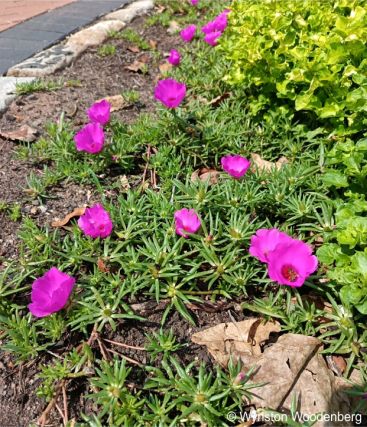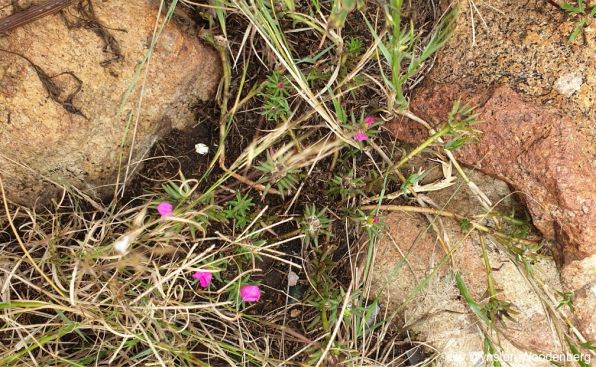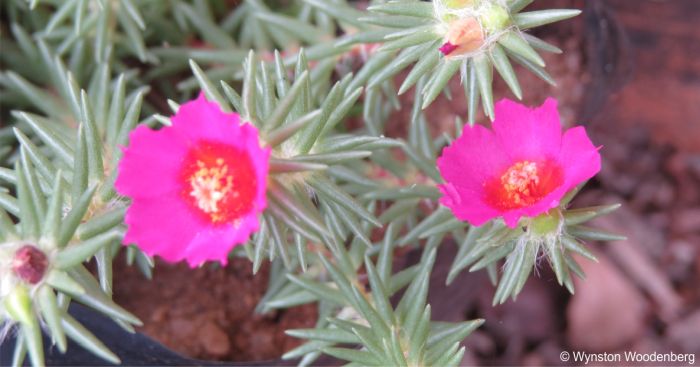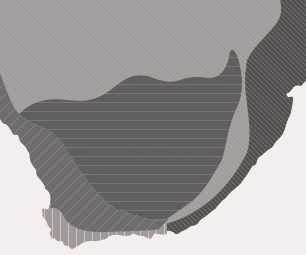Portulaca grandiflora
Portulaca grandiflora Hook.
Family: Portulacaceae
Common names: moss rose, moss-rose purslane, eleven-o’clock, rose moss, sun rose (Eng.); potjielekkers (Afr.).
Introduction
Portulaca grandiflora, an evergreen succulent native to South America, is widely known as an ornamental plant and has naturalised in parts of South Africa. It forms a dense, stunning mat of succulent foliage, with beautiful, showy flowers that brighten gardens throughout the summer.

Description
Description
Portulaca grandiflora is a succulent herb that can be annual or perennial, with a procumbent (trailing) growth habit. Its stems grow up to 300 mm long, branching near the base, and have long, thin hairs at the nodes and around the flowers. The leaves are fleshy, sessile, alternate, cylindrical, and about 20 mm long, ending in a pointed tip. The large flowers are grouped in terminal clusters of 3 to 5. While magenta petals are common in naturalised populations in South Africa, the species also produces flowers in other bright colours such as pink, red, yellow, white or striped, with diameters of 25 mm or more. Flowering occurs from late spring through autumn. The flowers exhibit photonastic movement, closing at night and during cloudy or rainy days, and reopening when sunlight is present. The fruit is a capsule, 4.0 to 6.5 mm, which splits transversely at its midpoint. The seeds are small, kidney-shaped, rounded or elongated, and iridescent grey-black to black, with surfaces predominantly covered with star-shaped cells.

Conservation Status
Status
Portulaca grandiflora is categorised as Least Concern (LC) on the Red List of South African Plants, meaning it is presently at low risk of extinction.
Distribution and habitat
Distribution description
Native to the hot, dry plains of Argentina, southern Brazil, and Uruguay, Portulaca grandiflora has escaped from gardens and naturalised in the warmer regions of South Africa, including Gauteng, Limpopo, and North West.

Derivation of name and historical aspects
History
The genus name Portulaca was given by Linnaeus, referencing the plant’s seed capsule, which opens like a small gate. The name is derived from the Latin portula meaning ‘little gate’ and lac, meaning ‘milk’, which is also part of the name due to the plant's milky sap. The species name grandiflora is derived from the Latin words grandis,meaning ‘large’ and flos, ‘flower’, referring to its relatively large flowers compared with other Portulaca species.

Ecology
Ecology
The showy flowers of Portulaca grandiflora attract bees and butterflies, which help in pollination. The plant’s small seeds are easily dispersed by wind. The plant is tolerant dry conditions, its succulent leaves and stems store water, allowing the plant to survive dry spells.
Uses
Use
Portulaca grandiflora is widely used as an ornamental landscaping plant. There are no medicinal uses recorded for this species in southern Africa, however, in Thailand, it is used medicinally to treat skin rashes, sore throats, and for detoxification. Its leaves help with scurvy, and it is used in Chinese medicine for malignancies, including as an ingredient in Tumoclear (Kang zhong pian) for tumours and cancer.

Growing Portulaca grandiflora
Grow
Portulaca grandiflora should be planted after the danger of frost has passed. It requires full sun, as its flowers only open in sunlight and close at night or on cloudy days. The species thrives in poor, sandy, or gravelly soil but can also grow in any well-draining soil. While drought resistant, it benefits from moderate, regular watering during hot and dry periods. Poorly drained soils, however, can cause crown rot.
Portulaca grandiflora can be propagated either by seeds or by shoot cuttings.
For seed propagation, the very small seeds should be mixed with sand for easier distribution and sown in seedling trays or directly into well-prepared garden beds in spring or summer. Germination occurs best at temperatures between 24 and 26°C and requires light, so the seeds should not be covered. Seeds typically germinate in 2 to 4 days in ideal conditions, but may take longer in cooler soil. Plants will bloom 12 to 14 weeks after sowing. Seedling trays should be placed in a bright, warm location, as Portulaca is sensitive to cool temperatures and low light. The seedlings quickly grow to about 100 to 150 mm in height and spread around 300 mm wide. In warm climates, P. grandiflora may self-seed in the garden, but direct sowing into the ground is recommended, as the plants do not respond well to transplantation.
Vegetative propagation of this species is done by taking cuttings of plant stems with leaves and nodes (areas where leaves attach to the stem). The stem should be about 200 mm long, with 8 to 12 nodes. Root formation is facilitated by the presence of a node, and the cut end of the stem should be planted in soil, allowing adventitious roots to form at the nodes. New leaves will appear in about 21 days, and applying fertilizer can encourage faster growth.
Portulaca grandiflora needs minimal pruning. The plants self-clean by dropping faded blooms and don’t require deadheading. However, a mid-summer trim can rejuvenate the foliage and encourage flowering into autumn. This plant is ideal as an edging or groundcover for beds, rock gardens, or along walkways. It also thrives in containers, hanging baskets, and can spill over stone walls. Although aphids and slugs can occasionally affect it, Portulaca grandiflora is perfect for poor, dry soils where other plants may struggle.
References
- Aisyah, S.I., et al. W. 2022. The diversity of agromorphological characters of Portulaca grandiflora in the MV8 population deriving from recurrent irradiation. Biodiversitas: Journal of Biological Diversity 23(9): 4432–4439.
- Gardening in South Africa. Portulaca vygie, Purslane, Moss Rose - Portulaca grandiflora. https://www.gardeninginsouthafrica.co.za/bedding-plants/portulaca-vygie-purslane-moss-roseportulaca-grandiflora. Accessed 29/07/2024.
- Hooker, W.J. 1829. Portulaca grandiflora. Large-flowered Purslane. Curtis's Botanical Magazine 56: t. 2885.
- Hyde, M.A., Wursten, B.T., Ballings, P. & Coates Palgrave, M. 2024. Portulaca grandiflora.Flora of Zimbabwe. Online. https://www.zimbabweflora.co.zw/cult/species.php?species_id=228700.
- Li, K., Xia, T., Jiang, Y., Wang, N., Lai, L., Xu, S., Yue, X. & Xin, H. 2024. A review on ethnopharmacology, phytochemistry, pharmacology and potential uses of Portulaca oleracea L. Journal of Ethnopharmacology 319(2): 117211.
- LLIFLE. Portulaca grandiflora. https://llifle.info/Encyclopedia/SUCCULENTS/Family/Portulacaceae/29300/Portulaca_grandiflora. Accessed 8 August 2024.
- Mane, S.T., Shinde, M.G., Supekar, A.R. & Agawane, S.S. 2022. A review on nutritional constituents and medicinal values of Portulaca grandiflora Hook. International Journal of Pharmacy & Pharmaceutical Research 24: 253–263.
- Raimondo, D., Von Staden, L., Foden, W., Victor, J.E., Helme, N.A., Turner, R.C., Kamundi, D.A. & Manyama, P.A. (eds) 2009. Red list of South African plants. Strelitzia 25. South African National Biodiversity Institute, Pretoria.
- Walters, M., Figueiredo, E., Crouch, N.R., Winter, P.J.D., Smith, G.F., Zimmermann, H.G. & Mashope, B.K. 2011. Naturalised and invasive succulents of southern Africa. ABC Taxa 11: 37.
- WFO The World Flora Online. Portulaca grandiflora Hook. http://www.worldfloraonline.org/taxon/wfo-0000489276. Accessed 31 July 2024.
Credits
Aviwe Khuzani & Wynston Woodenberg
KwaZulu-Natal Herbarium
May 2025
Plant Attributes:
Plant Type: Bi/Annual, Ground Cover, Shrub
SA Distribution: Gauteng, Limpopo, North West
Soil type: Sandy, Loam
Flowering season: Spring, Early Summer, Late Summer, Autumn
PH:
Flower colour: Red, White, Pink, Yellow
Aspect: Full Sun
Gardening skill: Easy
Special Features:
Horticultural zones











Rate this article
Article well written and informative
Rate this plant
Is this an interesting plant?
Login to add your Comment
Back to topNot registered yet? Click here to register.